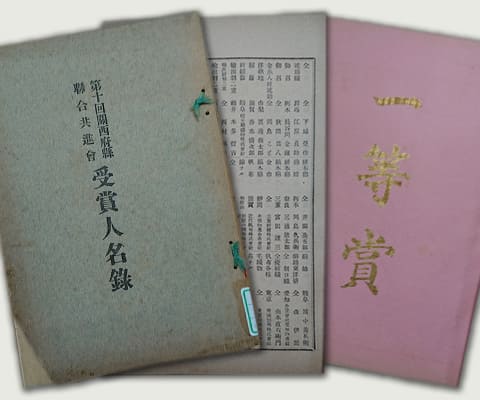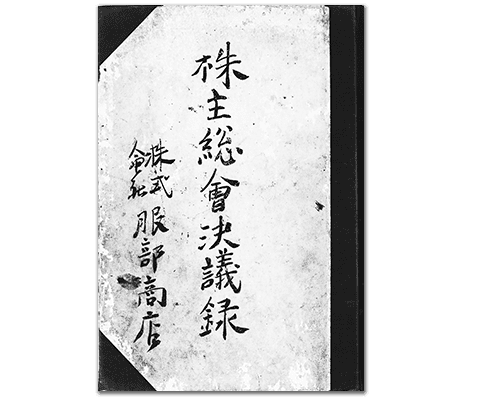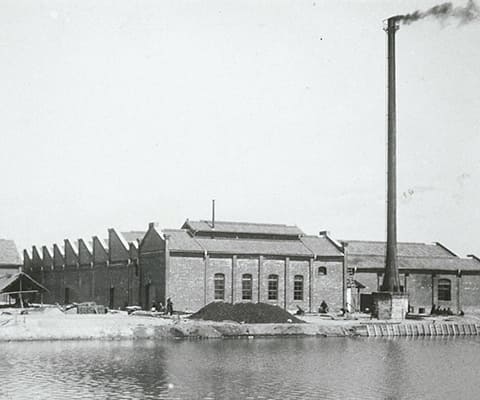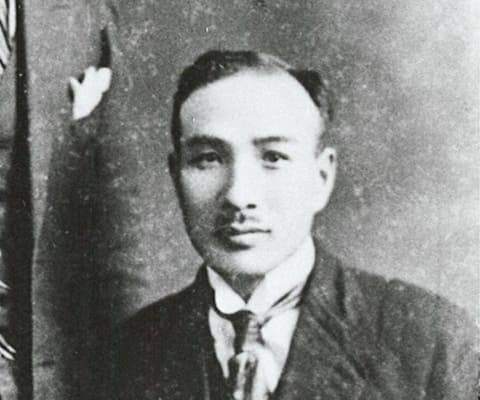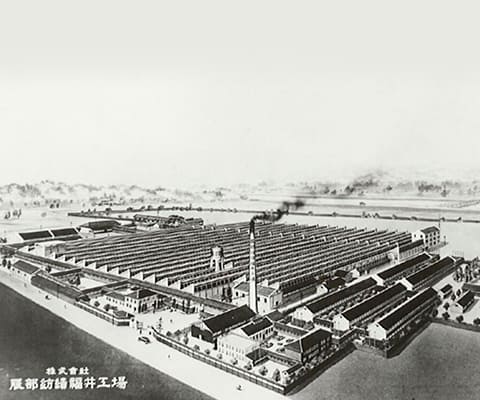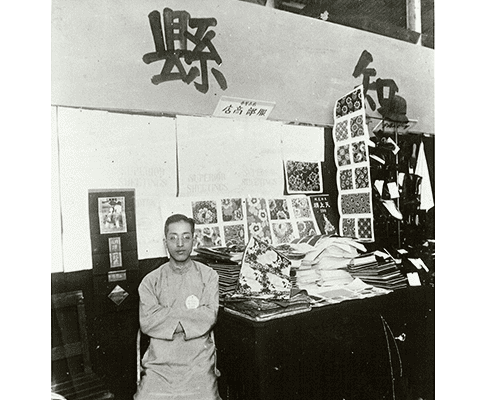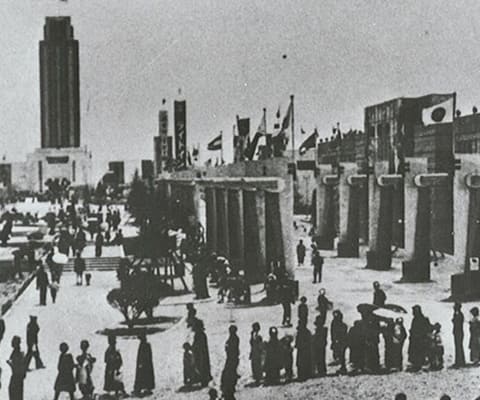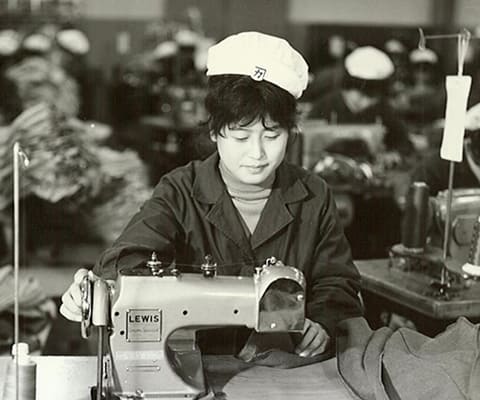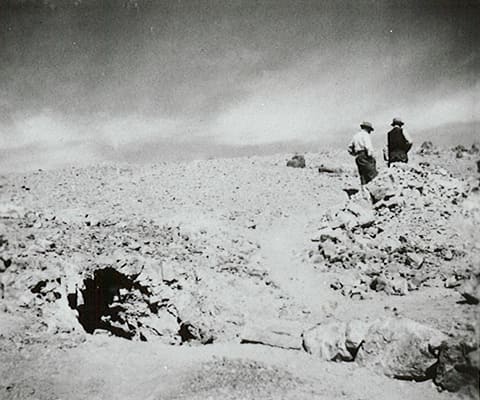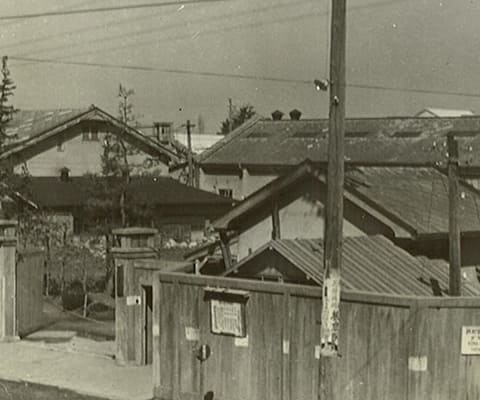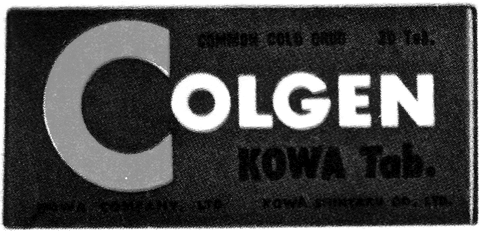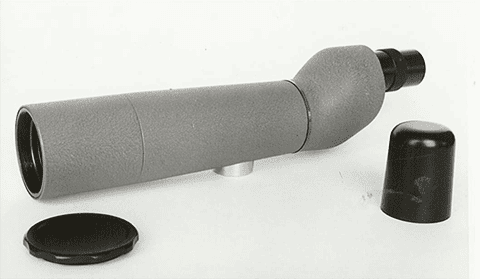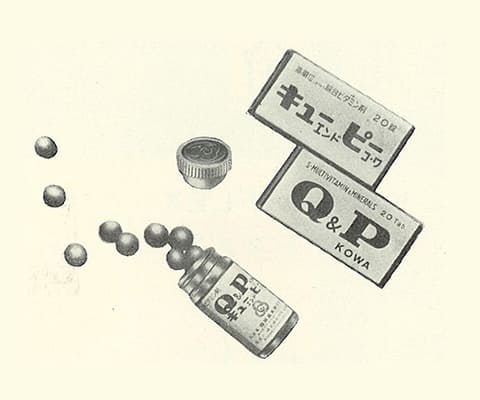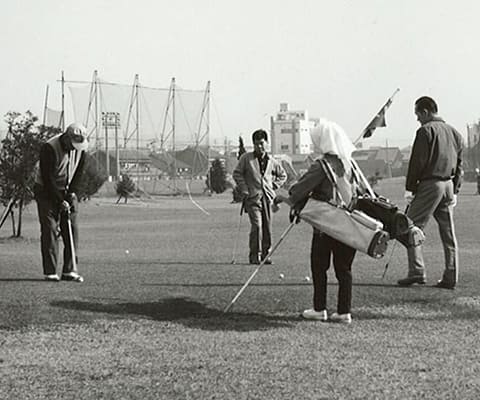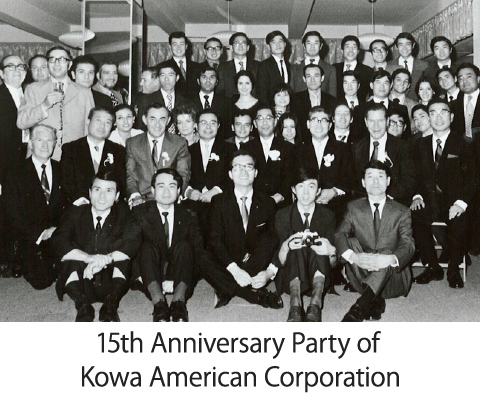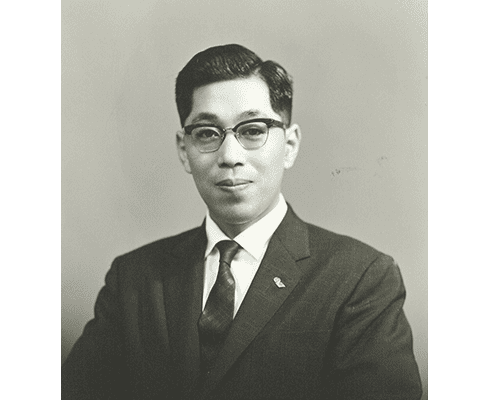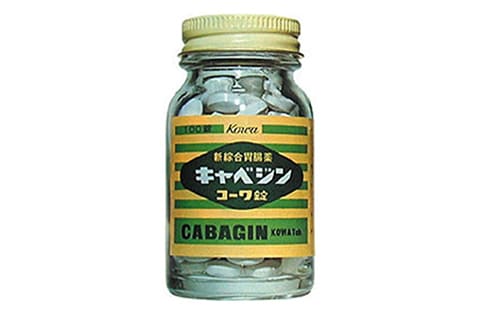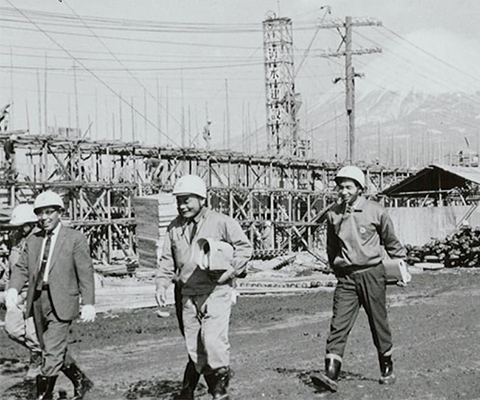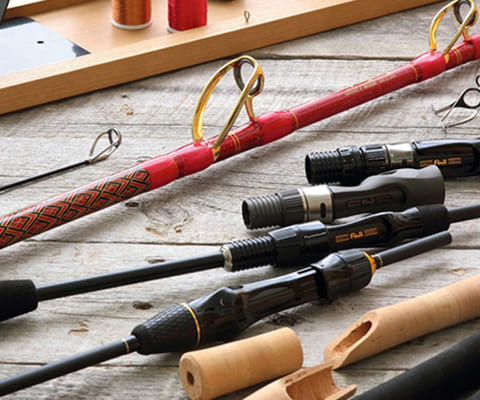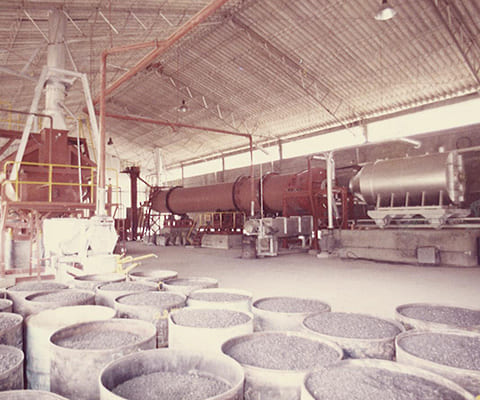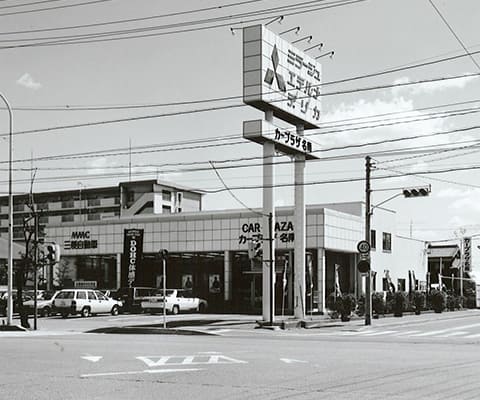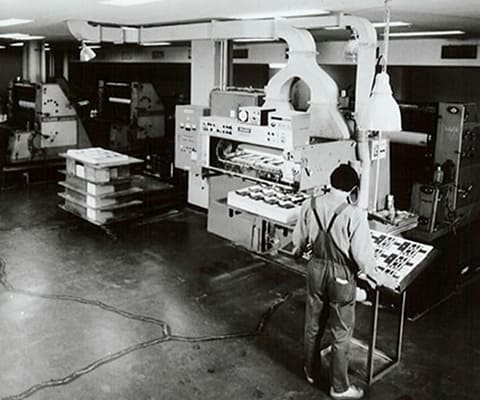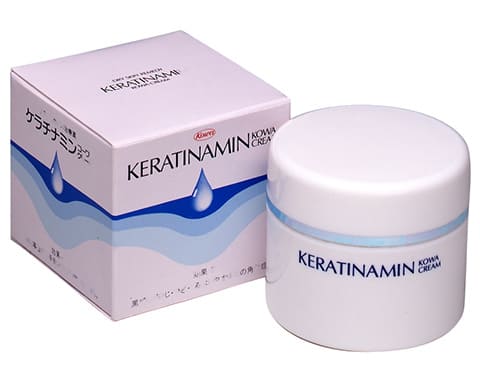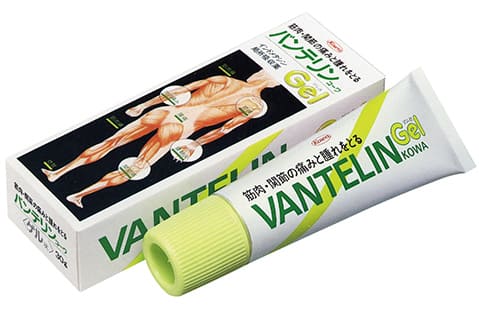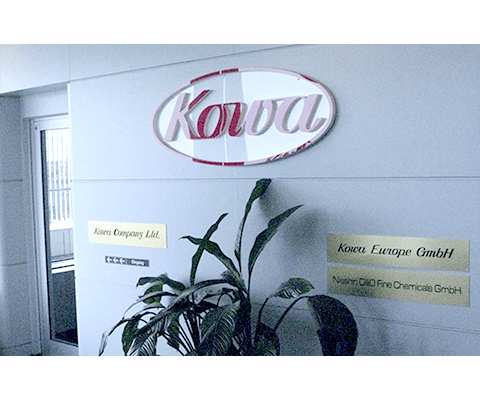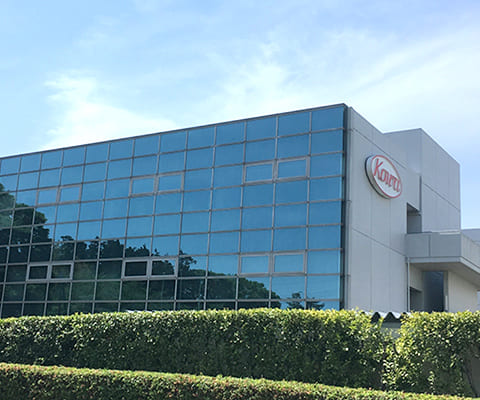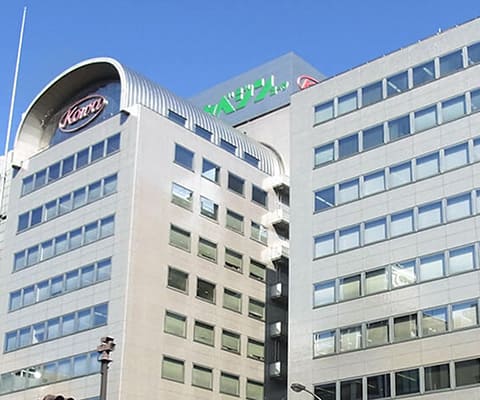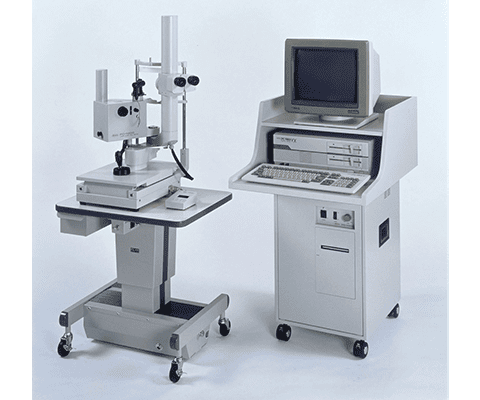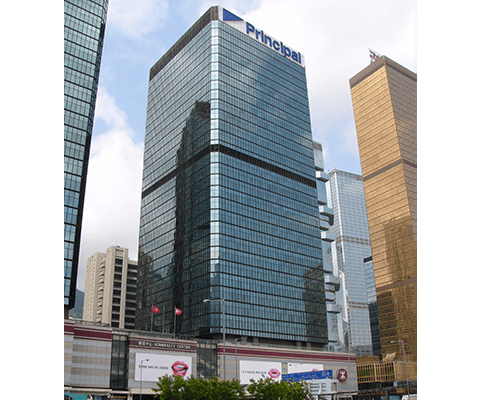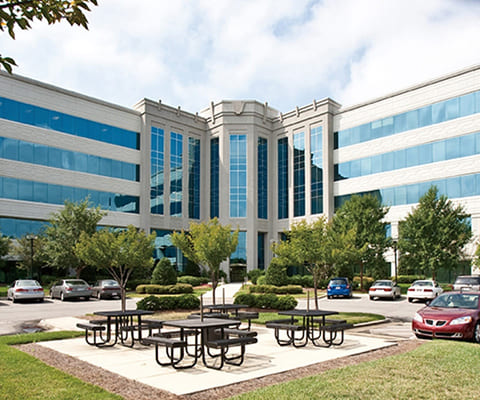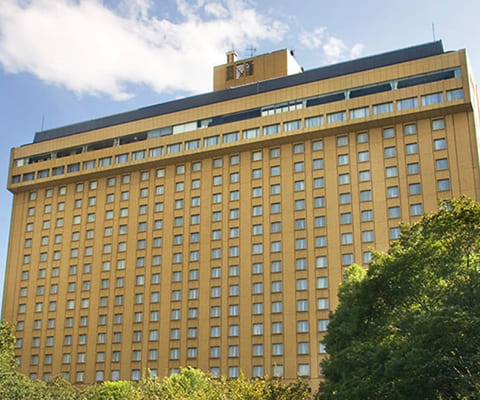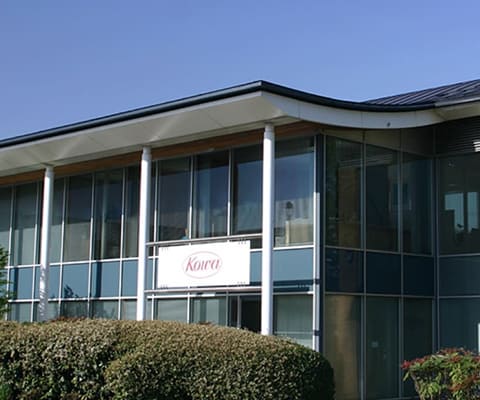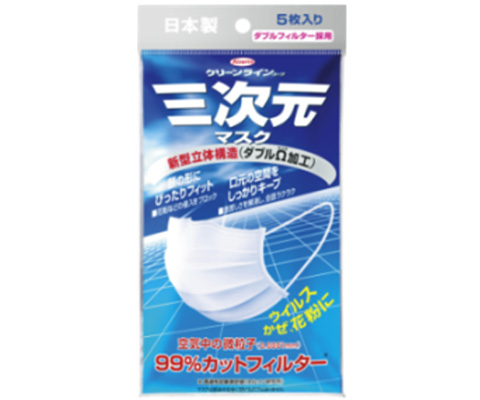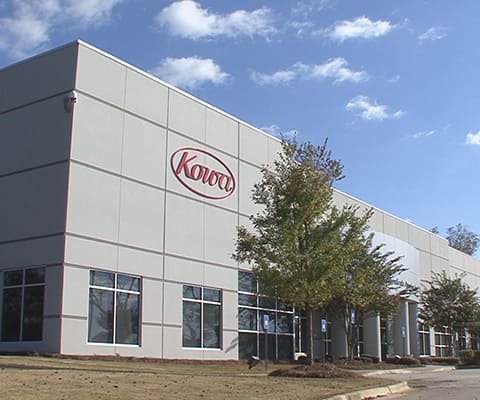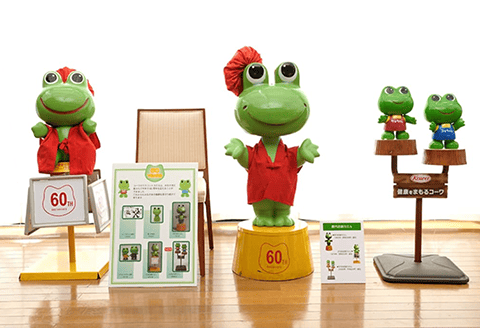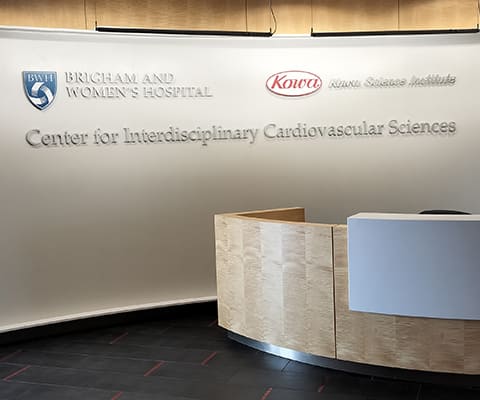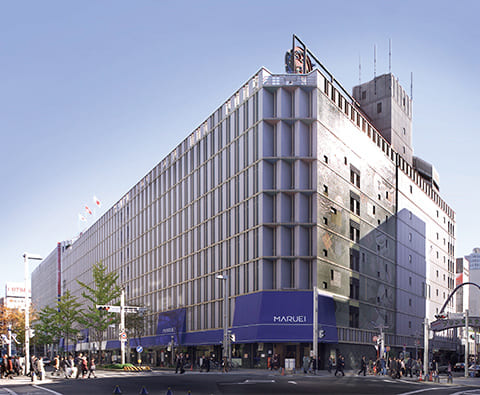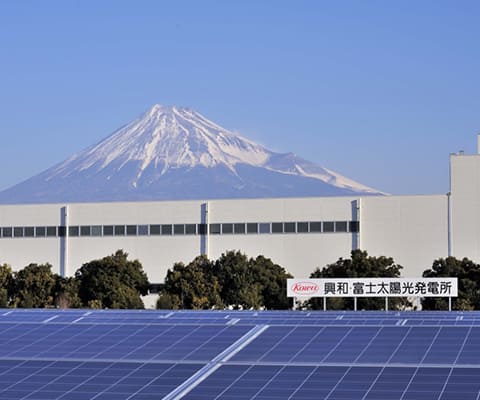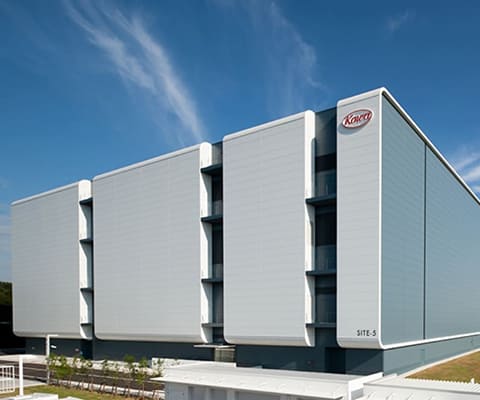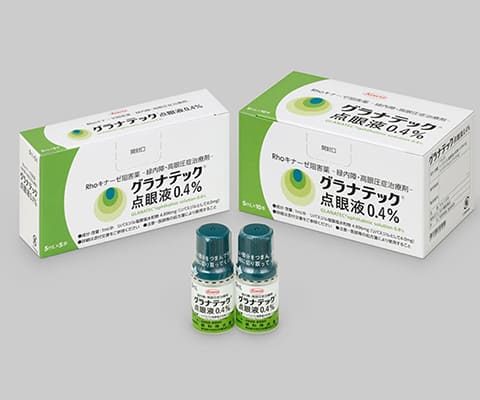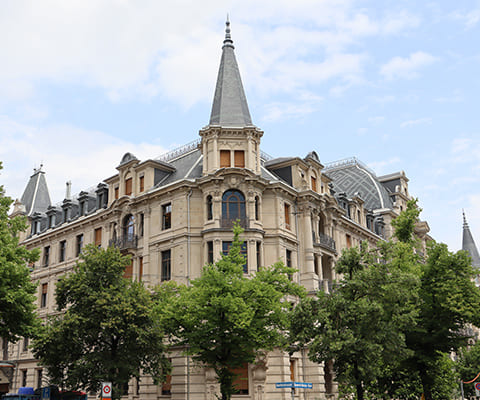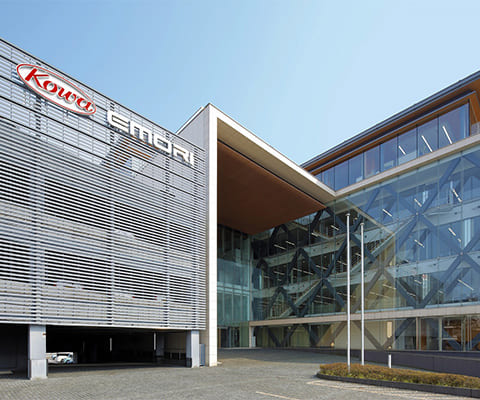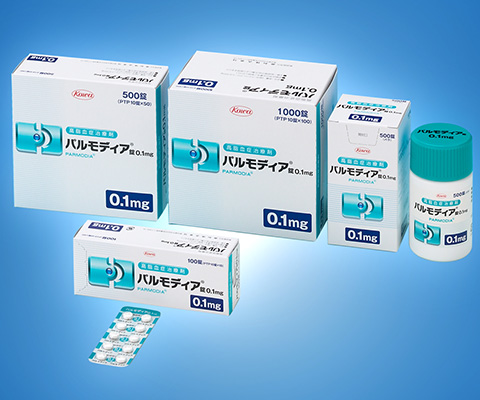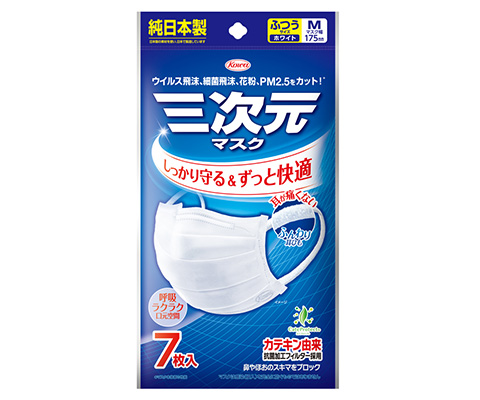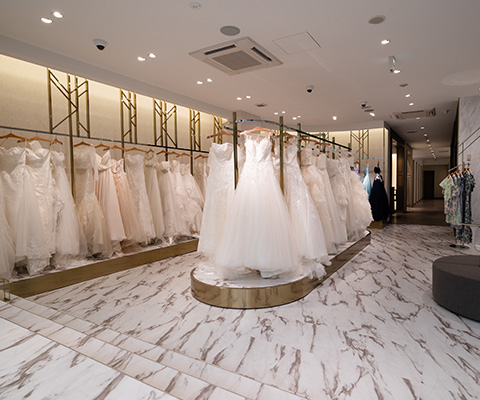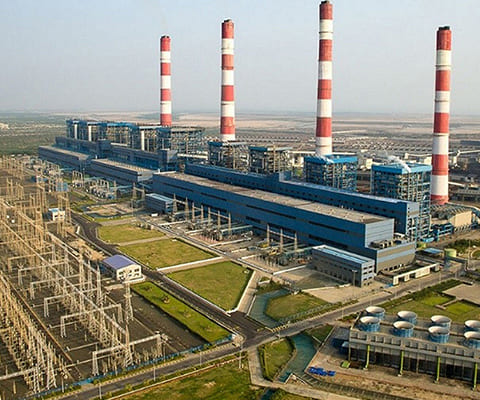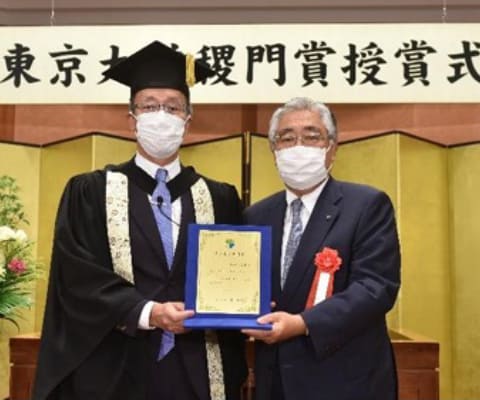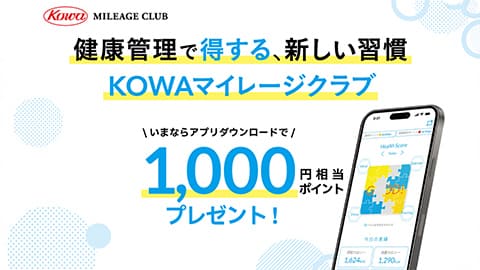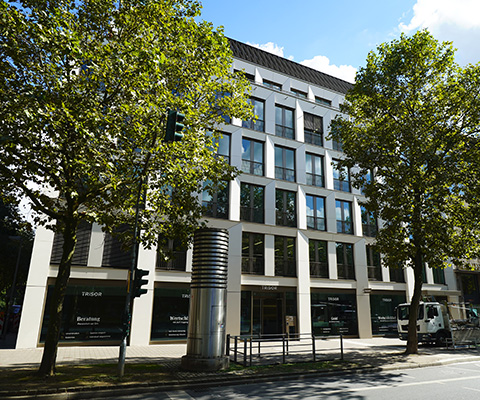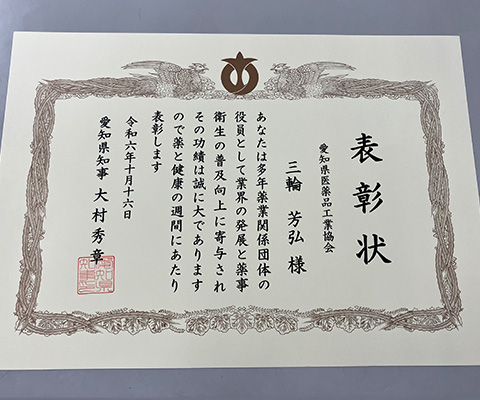The History of
Kowa Group

From the founding to prewar and wartime periods –
The early years of the Kowa Group
1 8 9 4  1 9 4 5
1 9 4 5

- A cotton fabric wholesaler, “Hattori Kanesaburo Wholesale Store” was founded.
- The history of the Kowa Group dates back to foundation of a private store, “Hattori Kanesaburo Wholesale Store,” which was founded by Kanesaburo Hattori by naming after him in 1894. At first, the store was originally engaged in collection of tie-dyeing and Chita cotton.
1906
- Tsunejiro Miwa visited and was stationed in various countries overseas.
- From 1906, Tsunejiro Miwa in his younger days, who later became the president of Hattori & Co., Ltd., started to visit and be stationed in various regions in Asia, such as China and Taiwan. He had just turned 20, but went abroad alone. Energetically visiting various places, he made a huge contribution to expansion of the business in overseas markets.
- Won the first prize at a major exhibition held in Aichi.
- Hattori Kanesaburo Wholesale Store exhibited its product in an exhibition held in Aichi which was a largest one in Japan at that time. The exhibition examined all the exhibited products to award prizes, and the “bleached cotton” of the Store was highly evaluated with its quality and won the first prize. This episode shows that the Store had reached the top level in terms of the quality control and brand strategy as well as the sales volume.
- “Hattori & Co., Ltd.” was founded.
- With the aim of expanding its business, Hattori Kanesaburo Wholesale Store was transformed to a joint-stock company and changed its trade name to “Hattori & Co., Ltd.” This transformation required the Company to clarify the corporate structure, which means modernization of management. It was a critical step for Hattori & Co., Ltd. to break away from a cotton cloth fabric wholesaler and take a leap forward as a textile trading company.
- The Sakurada factory was newly constructed and cotton fabric manufacturing started.
- Hattori & Co., Ltd. started cotton fabric manufacturing to fully enter the textile business. The equipment at the time of establishment comprised 4 sizing machines and 308 looms. Later, the second and third factory were built and the Sakurada factory successfully developed into a cotton fabric manufacturing factory having 1,164 looms in the peak period.
- Taizo Ishida joined Hattori & Co., Ltd.
- During this period, Taizo Ishida, who later became famous as “The Great Banto of Toyota,” worked at the Company and made a great achievement. Immediately after joining the Company, he was assigned to Shanghai and produced great results by fully deploying his natural business ability and enthusiasm. When the Company fell into financial difficulties, he scrambled to revitalize the Company with Tsunejiro Miwa.
- The Atsuta Factory was newly constructed and spinning business started.
- The first spinning Factory of Hattori & Co., Ltd., the Atsuta Factory, was constructed to enter the spinning business. Due to difficulties in purchasing equipment, start of operation was delayed and actually took place in 1919. The factory then successfully increased machines and buildings and developed into the core factory of the Company.
- Tsunejiro Miwa was appointed to the senior executive director.
(Senior executive director: The post of the chief executive in the Company at that time) - Kanesaburo Hattori, who was the representative of Hattori & Co., Ltd., took his own life because of the financial difficulties and was succeeded by Tsunejiro Miwa. Tsunejiro Miwa offered his own property as the collateral for the Company’s loan and firmly refused to receive remuneration from the Company. Such an attitude and spirit were gradually shared by the employees. He unified the shop staff nationwide with his leadership and paved the way for company revitalization, which has become the foundation of the Kowa Group’s prosperity to date.
1935
- The first overseas representative office was established in Bombay (current Mumbai in India).
- Since the beginning of 1900’s, some employees had been sent overseas to represent the Company. With the increase in export business, district offices and representative offices were established at various overseas locations and employees were deployed there since around 1935. India was an important country which was the largest export counterpart to Japanese manufacturers, ahead of China, from 1931. Accordingly, our first overseas office was established in Bombay.
- Exhibited products in the Manchuria Trade Fair.
- In the Manchuria Trade Fair, the Company’s own product printed in the Yadagawa Factory was exhibited. At that time, Japanese cotton industry was firmly developing toward its golden age. The business of Hattori & Co., Ltd. was also strong with increased overseas trades.
- Joined the Nagoya Pan-Pacific Peace Exposition.
- “Sodo jeans” sent to the Nagoya Pan-Pacific Peace Exposition received an honorary award and high-quality domestic product award. Hattori & Co., Ltd.’s Tsunejiro Miwa received the honorable certificate as the representative of the recipients of the award. One month after the Peace Exposition, the Second Sino-Japanese War began, which was drawn into a quagmire that lasted eight years.
- The Wakayama Factory was newly constructed and sewing business started.
- A group of 30 lockstitch sewing machines were set up in a corner of the Wakayama district office and sewing operations started. This was the first sewing factory of Hattori & Co., Ltd. As a result, an integrated production system from spinning, cotton fabric manufacturing, dyeing, and finally to sewing was established.
1939
- The trading and spinning divisions were separated as independent companies.
- Based on the business separation regulations by the Ministry of Commerce and Industry (current Ministry of Economy, Trade and Industry) promoting a controlled economy policy, the two divisions were separated from each other for the “separation of commerce and industry” and became the following independent companies:
- The trading division to Kaneka Hattori & Co., Ltd (current Kowa Company, Ltd.)
- The spinning division to Hattori & Co., Ltd. (current Kowabo Company, Ltd.)
- A representative office in Chile was newly established.
- There was an increasing demand in Chile for “Osnaburg” (cotton fabric for flour bags sewn with low-count yarn), bleached cotton fabric and yarn-dyed cotton purchased from Japan. In 1941, cobalt ore was shipped from Chile to Japan as a strategic material.
1945
- “Kowa” was used in the Company name for the first time.
- Company name changed from Koa Spinning Co., Ltd. to Kowa Spinning Co., Ltd. Regarding the Company name change, the name “Kowa” embodies sincere anticipation and resolution to restore peace to Japan and bring prosperity to the Company.
The
History of
Kowa Group
History of
Kowa Group
Learn more
Close
After the war –
The Kowa Group’s challenge to new businesses
1
9
4
6
 1
9
5
9
1
9
5
9

- Kowa Optical Works was established to enter the optical business.
- As a new business division, Kowa Optical Works was established to start manufacturing of eyeglass lenses and opera glasses. Later, the division started to handle a wide variety of products, including projection lenses, spotting scopes and sightseeing telescopes.
- Kowa Chemical Works was established to start the pharmaceutical business.
- To enter the pharmaceutical business, as a peaceful industry after the war, that protects health of all people, the Kowa Chemical Works Nagoya Factory was constructed in Nagoya and the Kowa Chemical Works Tokyo Laboratory in Tokyo. Since it was a new field of business, Kowa Chemical Works had struggled with production at the beginning, but continued to make efforts to develop new drugs to successfully foster the pharmaceutical business to become a pillar of our business.
- The first spotting scope in Japan was launched.
- The spotting scope was commercialized for the first time in Japan. It was originally developed for observing the target in shooting sports. Due to its outstanding optical performance and robust structure, this product gradually dominated the overseas market. Some years later, the product was used and played an important role in the shooting competition in the 1964 Tokyo Olympic Games.
- The headquarters moved to the current location.
(current address: 6-29, Nishiki 3-chome, Naka-Ku, Nagoya) - The space of the former office building became too small, so construction of the new office building that deserved to serve as the core of the Kowa Group in Naka-Ku, Nagoya, was determined. The head office functions of the group companies were consolidated to further improve business efficiency.
1954
- Kowa Shinyaku Co., Ltd. was established.
- Before the establishment, all the pharmaceutical products used to be sold through existing medical wholesalers. However, when the wholesalers suffered financial problems, our own sales organization was planned to be established as the sales channel, and Kowa Shinyaku Co., Ltd. was established.
1957
- Started handling wood and chemical products.
- Import of wood from Mindanao, Philippines, as a raw material of plywood was started. In the same year, raw materials for medicines that used to be supplied by other import companies were started to be handled by ourselves.
- The Kowa Golf Center was opened.
- Almost the entire Atsuta Factory was destroyed due to aerial attacks during the war. The old Factory was originally located at the center of Nagoya on a large site of about 132 thousand m2. As the number of golf enthusiasts increased from about 1955, the site was used to construct a golf center.
- Kowa American Corporation was established.
- In 1955, Kowa Optical Corporation was established in New York. As with the company name, its business was limited to the optical field. In 1958, the company was renamed to Kowa American Corporation, which started to sell various items, including optical devices, electronic equipment, miscellaneous goods, textiles, etc.
- Takayasu Miwa was promoted to the new leader of the Kowa Group.
- Takayasu Miwa was born in Nagoya as the third son of Tsunejiro Miwa. In 1959, he started to serve as the Presidents of three companies, Kowa Spinning Co., Ltd., Kofuku Sangyo Co., Ltd. and Kowa Shinyaku Co., Ltd. and then led the Kowa Group. In addition to the spinning business, he promoted development of the pharmaceutical and trading businesses to further advance business diversification after the war, which has built the foundation of the Kowa Group.
The
History of
Kowa Group
History of
Kowa Group
Learn more
Close
The Kowa Group –
Great progress along with the high economic growth
1
9
6
0
 1
9
9
4
1
9
9
4

1960
- The Company name was changed to “Kowa Company, Ltd.”
- The name of Kofuku Sangyo Co., Ltd. was changed to “Kowa Company, Ltd.” The three companies – Kowa Spinning Co., Ltd., Kowa Company, Ltd., and Kowa Shinyaku Co., Ltd. – now shared the same name of “Kowa,” which clearly showed establishment of the Kowa Group. Since “Kowa” had already been used in the pharmaceutical products’ names, the change of the Company name had a great advantage in marketing.
- A general-purpose gastrointestinal medicine “CABAGIN KOWA” was launched.
- Focusing on MMSC (methylmethionine sulfonium chloride) contained in cabbages, development of a product containing MMSC as a major ingredient was promoted and a gastrointestinal medicine “CABAGIN KOWA Tablets” was released. Since it was released, Kowa Company has continued product improvement to meet the needs of the times and the social environment. “CABAGIN KOWA” will continue to evolve as a gastrointestinal medicine protecting stomachs of people in Japan beyond generations.
- The “Kowa RC” retinal camera was launched.
- Development of the retinal camera, “Kowa RC,” later contributed to promoting development of medical devices. Because “Kowa RC” was a hand-held type retinal camera, it was widely used for examination of patients who cannot be moved and mass health examination.
1963
- Started expanding its business into Europe.
- The Brussels representative office was established. Mainly focusing on export of optical products from Japan to Europe, Kowa Company was also engaged in import of various goods, building materials, machines, chemical products, etc. and steadily boosted its performance.
1963
- Started import of machinery.
- The first machine imported was a capsule filler from Italy.
- The Fuji Factory was constructed as new facilities for pharmaceutical products.
- The completion of the Fuji Factory established the two-Factory system: the Nagoya Factory produced a wide variety of products in small lots, and the Fuji Factory handled the mass production of products such as CABAGIN.
1968
- Started real estate business.
- Kowa Estate Co., Ltd. was established to enter the real estate business. Mainly focusing on sale of ready-built houses and condominium, the company successfully developed the business.
1983
- Fuji Research Laboratories and Chofu Research Laboratories were newly established.
- Research of pharmaceutical products had been conducted only in the Tokyo Laboratories since 1964, the Fuji Laboratories, however, was newly established to update and improve research facilities. Research and development of electronic and optical businesses had been proceeded with by the engineering divisions at the Gamagori and Chofu factories, and the Chofu Research Laboratories was newly established in order to work on state-of-the-art technology development and basic research.
- Topical anti-inflammatory analgesics medicine “VANTELIN KOWA” was launched.
- As the first nonprescription drug that enabled local penetration of indomethacin, this product was launched. Even now, Kowa Company is continuously focusing on improvement of the preparation and evolving the product, for example by changing the formulation and improving the package, according to changes in the social environment.
- The new headquarters building of the Kowa Group was constructed.
- The new headquarters building adopted an innovative structure suitable for the new domestic base of the Kowa Group. It consists of two buildings, the main building and the south building. Bridge-type passages connect the two buildings on the 5th and 10th floors.
- The “Laser Flare Cell Meter FC-1000” was launched.
- Kowa developed the “Laser Flare Cell Meter FC-1000,” which is achievement of the advanced laser application technology, in cooperation with the University of Tokyo and the Jichi Medical University. It has continuously been improved and become widely used in ophthalmological clinics to examine eye inflammation due to insertion of a IOL (intraocular lens) for cataract treatment.
Learn more
Close
Strive to form a new future focused on
“Health and Environment”
1
9
9
5
 To
the
future
To
the
future

- Yoshihiro Miwa was appointed to the President.
- From not only a domestic but also a global viewpoint, Yoshihiro Miwa led business activities of the whole Kowa Group, while seeking to build a consistent supply chain from upstream to downstream. Under the new President, the Kowa Group has overcome the subsequent difficult times with proactive management.
- The UK-based affiliated company Kowa Research Europe, Ltd. was established.
- Kowa Pharmaceutical Europe Co. Ltd., a company engaged in production and sales of the pharmaceutical products in Europe, was established. With the new company, an integrated system from research and development to production and sales was established in Europe.
2003
- Nikken Chemicals Co., Ltd. became a subsidiary.
- As Kowa Company, Ltd. was doing its best efforts to sell “LIVALO Tablets” after acquiring the production approval, it recognized the necessity of a network consisting of 1,000 medical representatives. In addition, along with increased worldwide competition, there was an urgent need to build globalized systems of research, development and sales. Kowa Company, Ltd. therefore acquired Nikken Chemicals Co., Ltd. as a subsidiary to expand the business through active alliance with the company. Furthermore, in 2006, Kowa Company, Ltd. acquired 100% ownership of Nikken Chemicals Co., Ltd. and the sales divisions of both companies were integrated so that the alliance could be strengthened. The company name was changed from Nikken Chemicals Co., Ltd. to Kowa Pharmaceutical Co. Ltd. as a core company in the prescription drug business of the Kowa Group.
- Kowa Company, Ltd. purchased ProEthic Pharmaceutical, Inc. and changed its name to Kowa Pharmaceuticals America, Inc.
- Kowa Company, Ltd. bought out ProEthic Pharmaceutical, Inc. for the purpose of selling the prescription drug LIVALO Tablets and securing a subsequent pipeline in the United States. As a result, the global trilateral sales system covering Japan, Europe, and the United States was established.
- 60th anniversary of Kowa’s mascot frog.
- This mascot first appeared in a newspaper advertisement in 1949. Since then, it has been admired as the character for the cold medicine COLGEN KOWA Series. This year, the 60th birthday of the mascot frog was celebrated in some events, such as a party on a ship.
- The “Center for Interdisciplinary Cardiovascular Sciences: CICS” as a research development base for medical products in Boston in the U.S. was established.
- CICS is a laboratory facility where the laboratory workers in Kowa Company, Ltd. and scientists from Harvard University Hospital work together on discovery and development in interdisciplinary cardiovascular sciences. Kowa Company, Ltd. is expanding the Company technical base and promoting pipeline research (development theme products) with the collaboration of leading-edge research from the Faculty of Medicine, Harvard University.
2010
- Kowa Spinning Co., Ltd. was merged with Kowabo Company, Ltd.
- Kowa Spinning Co., Ltd. was merged with Kowabo Company, Ltd. on November 1, 2010. As a result, the name of “Kowa Spinning,” which had played an important role in Kowa’s history, disappeared. However, what we can say for sure is that improvement in management efficiency of the Kowa Group and business reconstruction were achieved, and the Group’s structure was successfully transformed to enable further development.
- Maruei Department Store Co., Ltd. became a subsidiary.
- Maruei Department Store had over 400 years of history and served as the face of Sakae, Nagoya, for many years. Since the 2000’s, however, the number of customers decreased and the sales rapidly declined due to redevelopment of the area in front of Nagoya Station, growth of other department stores starting later than Maruei, and decline in consumption after the Lehman shock. To respond to such situations, Kowa, which originated in the same place, Nagoya, as Maruei became the partner for the corporate reconstruction.
- Kowa Company, Ltd. entered into Mega Solar business, and completed the Fuji Photovoltaic Power Plant .
- As part of “Health and Environment,” Kowa has decided to contribute to realization of a decarbonized society through Mega Solar business utilizing renewable energy. The site area of the “Fuji Photovoltaic Power Plant” is 20,583 m2 where about 6,100 solar panels are installed to annually generate approx. 1,500,000 kWh.
- The Hamamatsu Factory was newly established. (production of pharmaceutical products)
- With the Great East Japan Earthquake as an opportunity, in order to disperse the manufacturing bases as part of risk management, this new factory was constructed to transfer part of pharmaceutical products produced at the Fuji Factory located along the sea to the Hamamatsu Factory located on the high ground.
2013
- Nagoya Castle Co., Ltd. became a subsidiary.
- Kowa Company, Ltd. acquired Nagoya Castle Co., Ltd. as a subsidiary and, along with Nagoya Kanko Hotel, started to be fully involved in management of the two major and traditional hotels in Nagoya.
- President and CEO Yoshihiro Miwa was appointed as Honorary Consul General of Thailand in Nagoya.
- President Yoshihiro Miwa of Kowa Company, Ltd. was appointed as “Honorary Consul General of Thailand in Nagoya” by the King of Thailand. This was the result of being given credit for contribution to development of friendly relations with Thailand through the Nagoya Honorary Consulate General of Thailand opened in KOWA building in 1956.
- PARMODIA TAB. 0.1mg was launched.
- Based on the concept of highly active and highly selective PPARα modulator (Selective Peroxisome Proliferator-Activated Receptor α Modulator, alias SPPARMα), Kowa started marketing PARMODIA (Pemafibrate), the world’s first self-developed therapeutic agent for hyperlipidemia.
2019
- Kowa Pharmaceutical Co. Ltd. (headquarters: Nagoya, Aichi) was established. Kowa Shinyaku Co., Ltd. and Kowa Pharmaceutical Co. Ltd. (headquarters: Chuo-ku, Tokyo) were merged.
- Kowa Shinyaku Co., Ltd., which had been engaged in sales of nonprescription drugs and healthcare products as a wholly-owned subsidiary of Kowa Company, and Kowa Pharmaceutical Co. Ltd., which had handled sales of prescription drugs as a wholly-owned subsidiary of Kowa Company as well, were merged by their parent company, Kowa Company, Ltd. Although the newly established Kowa Pharmaceutical Co. Ltd. (headquarters: Nagoya, Aichi) started to be engaged in sales of long-listed drugs and Authorized Generic (AG) products and provision of information, the company was dissolved and absorbed by Kowa Company, Ltd. on April 1, 2020.
- Kowa Company, Ltd. opened ESPACIO THE JEWEL OF WAIKIKI in Hawaii, U.S.
- Kowa’s first overseas super luxury hotel. “ESPACIO” means a “space” in Spanish. With the concept of “unprecedented surprise and impression, plus relax, healing,” the hotel has the best location commanding the Waikiki beach right in front. In addition to all-suite accommodation each of which occupies an entire floor, the hotel provides luxurious “hospitality.”
- Response to the spread of COVID-19.
- Since the beginning of 2020, the number of COVID-19 has spread around the world. In response to this COVID-19 pandemic, Kowa decided to make full use of the technology and production capacity that it had cultivated so far to significantly increase the production of masks and other products. As a mission of a pharmaceutical company, we contributed to health management and recovery of peaceful days.
- Expansion of Kowa's hospitality business.
- Watabe Wedding Corporation, which operates a wedding service business in Japan and overseas, became a wholly owned subsidiary of Kowa Company, Ltd. Our hospitality business included a new resort wedding business with synergy effects in addition to its existing hotel business such as Nagoya Kanko Hotel and ESPACIO THE JEWEL OF WAIKIKI.
- Started joint verification of ammonia co-firing technology to reduce CO2 emissions.
- In collaboration with “the Adani Group,” a leading Indian company, we have decided to work on demonstrating ammonia co-firing in thermal power plants in India with the aim of reducing CO2 emissions. At the end of 2022, we signed a comprehensive business agreement with the Adani Group to cooperate in the sale of green ammonia, which is made by renewable energy. We will contribute to the achievement of carbon neutrality together.
- Kowa Company, Co., Ltd. received the University of Tokyo’s Shokumon Award.
- Kowa Company, Co., Ltd. was evaluated as largely contributing to development of research activities of the National University Corporation, the University of Tokyo, and received the “University of Tokyo’s Shokumon Award” from the university on September 27, 2022. The Award is given to individuals, companies and groups that largely contributed to development of the activities of the university.
- The President and CEO Yoshihiro Miwa received the 74th Aichi Prefecture Award.
- The President and CEO of Kowa Company, Ltd., Yoshihiro Miwa, received the 74th Aichi Prefecture Award. Every year, Aichi Prefecture commends individuals or groups of people who have made distinguished achievement in the local autonomy, industry and educational culture, and the President Miwa, whose contribution to promotion and development of the pharmaceutical industry was highly evaluated, received the award as a “great contributor to health care.”
- The “KOWA MILEAGE CLUB” was newly introduced.
- For the purpose of supporting promotion of Japanese-style selfcare and contributing to achieving well-being of people, a state of being physically, mentally and socially fulfilled, a group-wide membership organization including all the departments and affiliated companies, the “KOWA MILEAGE CLUB,” was established and started to provide services and a dedicated application to the members.
- The President and CEO Yoshihiro Miwa received the “FY2024 Aichi Prefecture Pharmaceutical Affairs Contribution Award.”
- For his contribution to development of the pharmaceutical industry and spreading and improvement of pharmaceutical health and sanitation services as an executive officer of an organization in the pharmaceutical field over many years, the President and CEO Yoshihiro Miwa received the “FY2024 Aichi Governor’s Award for Contributors in Pharmaceutical Field.”
The
History of
Kowa Group
History of
Kowa Group
Learn more
Close


